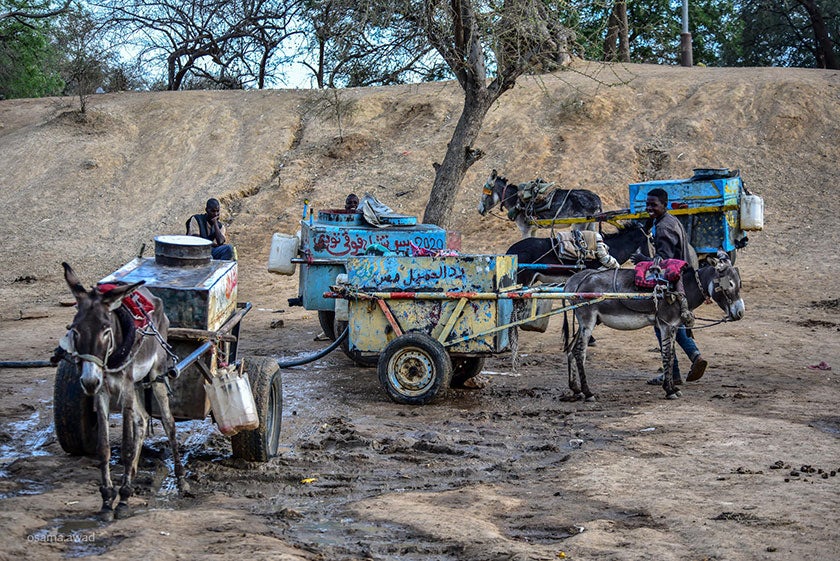 1st Winning Photo. Photo: Osama Awad
1st Winning Photo. Photo: Osama Awad
From deserts and mountains to marine, fresh water and woodland savanna, Sudan’s diverse land uses and ecosystems are under threat. Prolonged drought, climate change, conflicts, rapid urbanization and unplanned land-use conversion, if not controlled, will continue to wipe out the remaining scenic landscapes that represent Sudan, and most importantly, the communities that depend on them.
To mark this year’s World Day to Combat Desertification and Drought, the World Bank launched a photo contest to promote the role of digital storytelling in combating desertification in Sudan. Following a webinar organized jointly by the Bank, UNESCO and the Food and Agriculture Organization, Sudanese photographers were invited to submit photos covering four main themes: natural resources management, water and land, people and resilience, and technology and nature-based solutions.
In just 45 days, 38 photographers shared 89 compelling images that collectively told the story of the country’s diverse ecosystems and the remarkable resilience of the Sudanese people as they face the challenges of climate change, desertification and drought.
Do you see what I see? Resilience and recovery amid risks


Water security and droughts amplify stories of personal resilience and tenacity. Drought and water shortages are common to many Sudanese. For some, water insecurity is so severe as though drought is a year-round affair. Climate change is further exacerbating this challenge in a country that is also confronting desert encroachment into arable agricultural lands.
Both the 1st place and 2nd place winning photos, along with other entries, tell the plight in different parts of the country. They drum the voices of both young and old who have to spend a major part of their day everyday looking for water that is often contaminated and not fit for domestic use. About 50.4% of the population must walk to collect water, among them 31.4% have to walk longer than 30 minutes.
To stem these challenges, the Sudan Sustainable Natural Resources Management Project (SSNRMP), one of two projects that sponsored the photo contest, prioritizes provision of sustainable and clean water. The project has successfully established five new water stations, constructed six water harvesting systems (hafirs), as well as rehabilitated six water stations at targeted sites in Gezira, Kassala and White Nile states, enabling access to water for domestic use and sanitation, watering livestock and irrigating crops.


“A Tree with Strong Roots Laughs at the Storm” Lone-standing trees, one of such in North Darfur, shows that some vegetation can adaptively resist extreme conditions. The last remaining adult tree in Sudan of the Nubian Dragon species, Dracaena ombet, is classified globally as endangered. Aside nature’s resilience, both the 3rd place winning photo and the photo of the Nubian Dragon Tree invoke the need for nature-based propagation approaches such as farmer-managed natural regeneration but more so the looming vulnerability of communities whose livelihood depend on them. The SSNRMP landscape restoration efforts promotes use of indigenous tree species in enriching forests and tree-based agricultural systems.

Swamps capture and retain flood waters releasing them at a pace that replenishes the water table. The Sunut Forest, the lung of Khartoum city, and ‘the water-sponge for the Niles in the city’ has a unique location lying at the confluence of the White Nile and Blue Nile. It is also a migratory route for birds. However, the Sunut Forest, like the other forests in the country, faces several stresses threatening its conservation and critical ecological services such as trapping flood waters and cleaning the air in the capital city. Illegal logging, deforestation, drought, and unplanned land use conversion are to blame. To counter this, the Sudan Reducing Emissions from Deforestation and Forests Degradation Readiness Program (REDD+), which also supported the photo contest, aims to equip government and community with the capacity to promote improved forest quality and sustainable development while eradicating poverty. In addition to a number of key studies, the REDD+ Readiness program has developed a National Forest Inventory to help access climate finance for sustainable forests management.


Connecting with Nature. Perhaps not as well-known as with other African countries, but Sudan harbors rich fauna and flora and iconic natural habitats with the potential for nature-based tourism. Reedbuck and other flagship species in the Dinder National Park, one of the largest and most important of the 14 national Protected Areas in Sudan, attracts largely local tourists and more than 300 foreign tourists annually. Sudanese deeply connect with their surrounding environment as captured in the 4th and 5th winning photos.
As custodians of the country’s natural assets, local communities protect and help secure the productive, aesthetic, cultural, medicinal and religious values. They are crucial stakeholders in efforts to sustain the country’s natural capital. The fourth winning photo reinforces empowering youth to optimize their connection with nature.

The fifth wining photo of a woman sitting on a riverbank in Magasir, one of the oldest islands evokes ‘return, recovery and restoration’. Having been forcibly displaced by successive floods, desertification and drought, the islanders have returned to re-green their homeland.
Even with the travel limitations during the COVID-19 (coronavirus) pandemic, photographers from across Sudan were able to bring their perspectives to bear on the challenges yet growing opportunities in sustainable land and water management. Their photos remind us that Sudan has some remarkable landscapes, unique fauna and flora worth preserving.




Join the Conversation